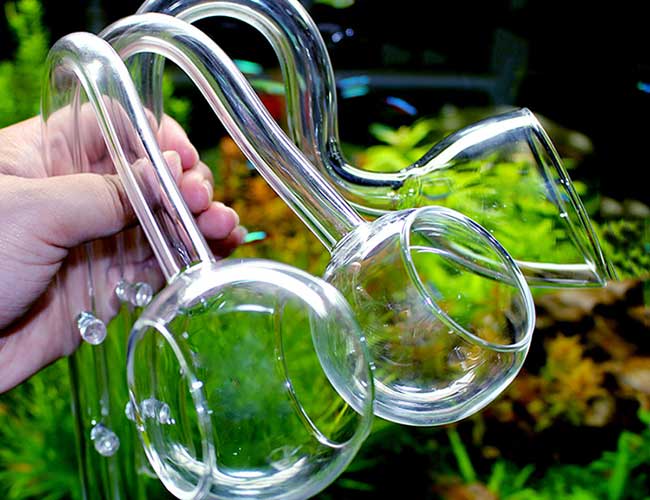Lilly Pipe
Aquarium enthusiasts are always looking for ways to make their aquariums more attractive, clean and easier to maintain. With advancements in technology, there are numerous accessories available for aquariums, including filters, pumps, and heaters. However, one of the most important accessories that many aquarium owners overlook is the lilly pipe.
The Pain Points of Aquarium Filtration
When it comes to aquarium filtration, many people don't consider the aesthetics of the equipment. Traditional filters and outlets tend to be bulky, ugly, and stand out of the aquarium's natural beauty. Also, not all equipment is specialized for planted aquariums, which could inhibit the plant growth and endanger the aquatic life. Water flow, algae buildup, and equipment failure can be other pain points experienced by aquarium enthusiasts.
What is a Lilly Pipe?
A lilly pipe or a glass inflow and outflow pipe is an aquarium accessory that is designed to enhance your aquarium's filtration by returning the treated water back to the tank in a more stylish and discreet way. It is made of quality materials, from glass to acrylic, and typically is designed to mimic the shape of a lilly blossom, hence the name. While their target is to improve filtration, they also help to aerate and circulate the water while minimizing dead zones and draft pattern.
Main Advantages and Disadvantages of Lilly Pipe
If you're new to the world of lilly pipes, here are some essential things you need to know:
Pros:
- Better water flow and distribution
- Discreet and appealing
- Suitable for planted aquariums
- Minimizes noise and disturbance
- Less prone to algae buildup
Cons:
- Can be fragile and break easily if not handled with care
- Expensive than traditional filters
- Not suitable for large aquariums
- Require thorough cleaning
My Personal Experience with Lilly Pipes
My aquarium hobby began a few years ago when I got two small tropical fish and a basic aquarium starter pack. Within a few weeks, I realized my filter was noisy, bulky, and taking half of the swimming space while not being able to clean the water effectively. After some research, I found out about lilly pipes and how they can improve the water flow while keeping the aesthetic of the aquarium. I got a set of inflow and outflow glass lilly pipes that were easy to assemble and install and improved the water flow and reduced the disturbance in the aquarium. The glass pipes also gave a unique and sophisticated look to my aquarium, enhancing the visual appeal of my aquatic plants and fish. Although they may require gentle handling, I consider them to be an important asset in every aquarium, especially in planted ones.
The Target of Lilly Pipes
Glass inflow and outflow lilly pipes are ideally designed to ensure optimal water flow and circulation in planted aquariums. One of the most significant advantages of using lilly pipes is to prevent dead zones in the aquarium where water flow is inadequate and where the waste can accumulate. Lilly pipes ensure that nutrients are distributed evenly throughout the aquarium while minimizing water disturbance and improving aeration.
The Maintenance of Lilly Pipes
Since lilly pipes are always in contact with aquarium water, algae buildup is inevitable. Therefore, cleaning is crucial to maintain their efficiency and durability. You need to regularly clean lilly pipes with a soft brush in mild soapy water or bleach solution to remove any buildup and deposits. Always rinse them thoroughly before re-attaching them to the aquarium filter system. Failure to maintain and clean lilly pipes can result in reduced water flow, algae buildup, and unpleasant odors.
Lilly Pipe vs. Canister Filter
A canister filter is another type of filter that is often used in aquariums for water filtration. While lilly pipes are known for their aesthetic appeal, canister filters are known for their efficiency in water filtration and their suitability for large aquariums. Canister filters can also be noisy and take considerable space in the aquarium. On the other hand, lilly pipes offer better water flow and circulation and are ideal for planted aquariums that require proper aeration and nutrient distribution.
Question and Answers about Lilly Pipe
Q. Can lilly pipes be used in saltwater aquariums?
A. Yes, lilly pipes can be used in saltwater and freshwater aquariums.
Q. Can lilly pipes be used in combination with a canister filter?
A. Yes, lilly pipes can be used with a canister filter as long as they are installed correctly and maintained periodically.
Q. How long do lilly pipes last?
A. With proper handling and maintenance, lilly pipes can last for a very long time, from 2-3 years to over a decade.
Q. How often should I clean my lilly pipes?
A. Lilly pipes require frequent cleaning because they come in constant contact with aquarium water. You should clean them at least once a month or more frequently, depending on the number of fish and plants in the aquarium.
Conclusion
Lilly pipes are essential to aquarium filtration, allowing for better water flow, aeration, and efficient nutrient distribution. With attractive design and multiple benefits, lilly pipes deserve a place in every aquarium enthusiast's toolkit. By following proper maintenance and cleaning techniques, they can last for years and keep your aquarium's aesthetic looking clean and polished always.
Gallery
Acrylic_Lily_Pipes_1 Photo By Dirk_morel | Photobucket
Photo Credit by: bing.com / lily pipe acrylic pipes aquarium photobucket ada morel dirk freshwater tank glass choose board
Aqua Rebell Glass Lily Pipe - Olibetta

Photo Credit by: bing.com / rebell olibetta
DYMAX CRYSTAL LILY PIPE WITH SURFACE SKIMMER 16/22 Mm - Aquascape
Photo Credit by: bing.com / skimmer aquascape dymax co2
Lily Pipes: Say Goodbye To Ugly Filter Equipment For Good!

Photo Credit by: bing.com / lily pipes glass pipe filter goodbye ugly say equipment good ian sterling updated january last comments
Glass Lily Pipe For 1/2 Inch,12/16 Ada Like For Planted Tank Aquarium,2

Photo Credit by: bing.com / lily pipe glass aquarium ada planted nails tank inch